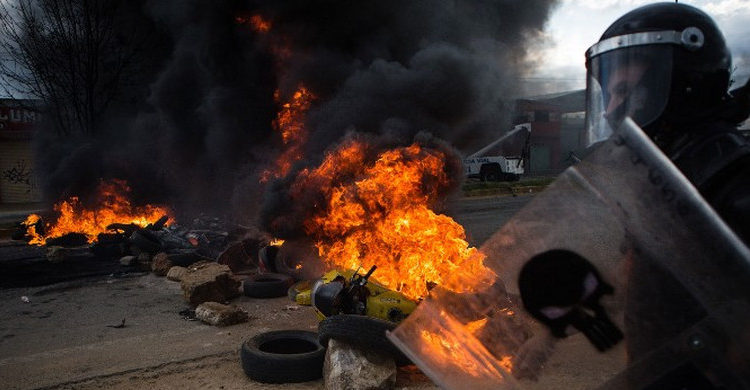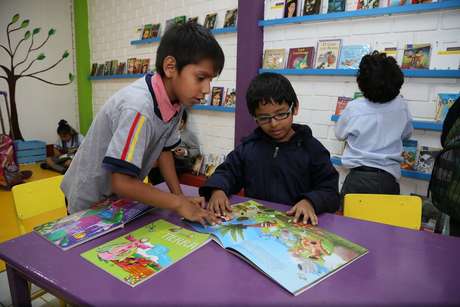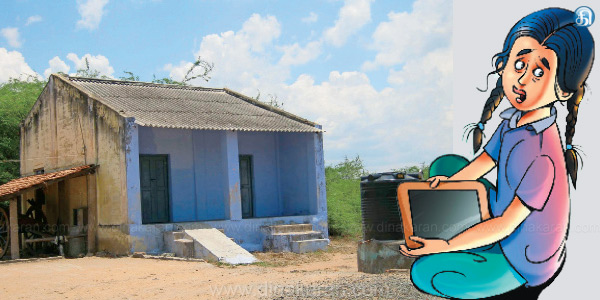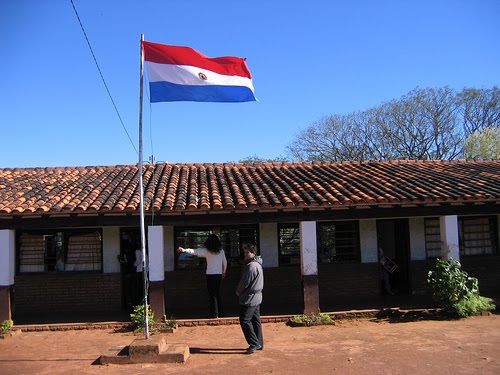América del Norte/México/Junio 2016/Autor: A.S. Dillingham and René González Pizarro / Fuente: Jacobin
Resumen: Los maestros en huelga mexicanos están luchando por la justicia en el aula – y contra el orden neoliberal violenta de México.
Ten years ago, as a group of striking teachers slept in their encampment during the early hours of June 14 in the state capital of Oaxaca, Mexico, government forces launched an attack to remove them from the zócalo, or town square. Riot police cleared the plaza while helicopters dropped tear gas from above.
The striking teachers were beaten, arrested, and pushed out of the city center. But not for long; the teachers and their supporters quickly regrouped, fighting back, block by block, and took the plaza back by midday.
The violent repression of striking teachers in 2006, ordered by the state governor, launched a social movement — called the “Oaxaca Commune” by supporters — that grew to encompass much more than the local teachers’ union.
The movement mobilized large swathes of Oaxacan society against the repressive governor. Aggressive federal intervention hobbled the movement, but failed to wipe it out. Today the dissident teachers’ movement is in the streets again, this time in opposition to the federal government’s “education reform” program.
The teacher’s movement is also more widespread than in 2006. Militarized attacks on striking teachers have occurred in Mexico City and throughout the country’s southern states. In the last month, the state of Chiapas has seen pitched battles between teachers and police forces, and the Zapatistas have spoken out in favor of the striking teachers.
Last week the Mexican attorney general’s office arrested two of the leaders of the Oaxacan section of the teachers’ union, Local 22, on corruption charges. Then on June 19, federal and state police attacked protesters in Nochixtlán, Oaxaca, a town on the highway between the state capital and Mexico City, resulting in the death of at least eight protesters.
The blatant attack on outspoken government opponents unleashed a wave of protests in the state capital in response.
It’s become somewhat of a cliché to describe the situation in Mexico as a “crisis.” Indeed, la crisis is frequently satirized in Mexican film and popular culture, with Mexicans unsure when the last crisis ended and the next began.
Yet it’s true that in Mexico has experienced a wave of tragedies since 2006. Over one hundred thousand thousand people have died, over twenty-five thousand have been disappeared, and more than one hundred journalists have been killed in the decade since former president Felipe Calderon declared war on the drug cartels.
Some of the crisis’s numbers are unforgettable. The forty-nine children burned to death in a government-outsourced daycare center without safety protections in the northern state of Sonora in 2009; the seventy-two migrants found in a collective grave in the state of Tamaulipas in 2010; and most recently the 2014 disappearance of forty-three Ayotzinapa Normal School students in the southern state of Guerrero. Tragedy’s numbers are a defining part of daily life and conversation in Mexico.
Enrique Peña Nieto’s election in 2012, coming after years of drug-war-related violence, was seen by many as a possible reprieve, a return to the nostalgic days of the Institutional Revolutionary Party (PRI) rule when governance was at least stable, if not democratic or transparent.
Yet President Peña Nieto’s sexenio (six-year term) has been marked by continued mass violence, corruption, and impunity at seemingly all levels of government. From shady government contracts in Mexico City, to his wife’s extravagant home paid for by dubious means, to the flagrant and repeated government lies over the forty-three missing students, Peña Nieto’s popularity has plummeted.
Recent state-level elections saw the PRI lose power in a number of its former strongholds. Mayors in Mexico are targeted by cartels, in a way that suggests they are siphoning funds directly from the state, in addition to drug and human trafficking.
The multiple captures and escapes of “El Chapo” Guzman, the infamous drug trafficker, lent credence to the popular belief among many Mexicans that the line between the traffickers and the state is blurry, at best.
Peña Nieto’s 2013 education reform plan — the piece of legislation under contention today — is just one component of a broader set of structural reforms pushed through by the president and the PRI.
While other reforms — such as the partial privatization of the state-run oil company, PEMEX, and corporate tax reform — have been relatively successful (on their own terms), the education initiative has proven the most difficult to implement, sparking opposition by not only the dissident section of the teachers’ union, the Coordinadora Nacional de Trabajadores de la Educación (CNTE), but also broader sectors of the national teachers’ union, the Sindicato Nacional de Trabajadores de la Educación (SNTE).
This opposition and the militarized approach of the government employed to implement the reforms, with thousands of federal police securing teacher testing sites, has led the international press, much of which until recently was supportive of Peña Nieto, to declare him a failure.
The education reform is better understood as an attack on labor. Much like the discourse of recent education reform movements in the United States, the Mexican reformers invoke notions of “accountability” and “quality” instruction.
But the reform itself contains numerous measures aimed at undermining the power of teachers’ unions including measures that weaken the union’s control of the hiring process at normal schools (which they historically controlled), eliminate teachers’ ability to pass down a position to their children, make it easier to fire teachers who miss work, and limit the number of union positions paid by the state.
These measures are all directly aimed at undermining the union’s power, but the central point of contention has been the evaluation of teachers through state-administered standardized tests.
At the end of last year, teachers across Mexico sat down for new nationwide teacher evaluations. In Oaxaca, the scene outside the testing site resembled a military exercise.
Ten thousand federal police were deployed to facilitate the administration of the evaluations, reflecting both the federal government’s desire to see their reform implemented as well as the widespread opposition to the new law.
Oaxaca is home to one of the most outspoken union locals in Mexico, Local 22, a member of the dissident CNTE movement — a movement that emerged in the late 1970s in opposition to the authoritarian, PRI-aligned SNTE.
In the 1970s and 1980s, the CNTE struggled against entrenched PRI control of union locals, with newly minted indigenous teachers playing a key role in southern states such as Oaxaca and Chiapas. The CNTE has remained a powerful force and controls, in addition to Local 22, sections of union locals in Michoacán, Guerrero, Chiapas, and the Federal District (Mexico City).
Given Local 22’s historic militancy, the state’s response was not surprising. Yet similar scenes of police coercion played out across the country, alongside a massive media campaign denouncing the dissident teachers’ union as self-interested and corrupt.
Historian A. S. Dillingham sat down with René González Pizarro, a Oaxacan teacher and member of Local 22, as well as a former delegate to its assembly, to discuss the nature of the reforms, the government’s strategy, and the history and culture of Local 22.
Can you first tell us a little about your own experience as a teacher? Why did you choose the teaching profession?
My professional training was originally in graphic design, but I’ve been immersed in the education world ever since I can remember. Actually, as a baby I was part of the teachers’ demonstrations of the 1980s and I remember that as a six- or seven-year-old I’d chant along with the slogans of the teachers.
After eight years teaching in private schools, I entered Local 22 thanks to my father. One of the benefits of the union members (eliminated by the recent reform) was the ability to inherit the position of one’s parents upon their retirement, as long as one had initiated their teacher training.
My father was in the indigenous education system, so I started there, with lowest category of promotor bilingüe or bilingual promoter. These positions were created in the 1970s and it is the category I continue to hold.
I started work in an indigenous boarding school in Coixtlahuaca, a rural, mountainous region in the western half of the state.
Let’s begin with the June 19 attacks on the teachers’ blockade in Nochixtán.
The federal and state police’s recent violence merely demonstrates the total obstinacy and refusal to negotiate on the government’s part. The teachers’ movement and much of the public generally have spoken out against the structural reforms, not just the against the education program.
On Sunday, the federal police first denied their use of live ammunition against demonstrators. Then later, after the confirmation of the first two dead, the secretary of government claimed it wasn’t police who fired, and said the photographs of police firing assault rifles were from another date and time.
But the media reaction was quick and the Associated Press confirmed the photographs of police firing on crowds were indeed from that Sunday and not manipulated.
Finally, at a press conference late that afternoon, the police admitted to their use of live ammunition.
The key from the government’s point of view has been the implementation of last year’s teacher evaluations. More than ten thousand federal police arrived in Oaxaca to facilitate the new evaluations.
The state government and Ministry of Education claimed it was a success. How do you view what took place with the evaluations?
The new state education ministry (IEEPO), which was legally reconstituted during the summer of 2015 to weaken the union’s control, has been trying to legitimize itself since its restructuring last July.
They’ve begun a series of actions, particularly on social media, to try to show that the Oaxacan teachers wanted to get rid of the “yoke” of the union.
On social media they have bombarded Oaxacans with messages like, “The new IEEPO is better, nothing remains in the union’s hands, now union coercion is no longer needed to access labor rights, the evaluation isn’t meant to take peoples’ jobs, now children will have all their classes.”
But the message is funny, if not ironic, in the face of the deployment of federal forces, not just in Oaxaca but in other states where the CNTE hasn’t had much presence.
Two or three years ago, before the reforms began in earnest, many non-CNTE teachers in the rest of the country viewed the evaluations as a good thing. (Actually some Oaxacan teachers did, as well.)
But with the full implementation of the reform there has been an upturn in the scale of opposition to it. Even in places where one hasn’t seen teacher protests before, one sees them now; the state of Jalisco and the state of Mexico are clear examples of this.
You mentioned the “new IEEPO” and what took place last July when the state government legally abolished — with the support of the federal police — the previous education ministry, in order to facilitate President Peña Nieto’s reforms.
How do you view that action? Does this constitute a death blow to Local 22’s power?
The government’s actions last July were a major blow to Local 22. But they weren’t a death blow. It wasn’t enough to merely freeze the union’s bank accounts, prosecute them financially, invent connections to organized crime, or try to do something from the financial side.
Nor has it been sufficient to detain the leaders. Actually, the detainment of four leaders and recently three members of Local 22’s executive committee sparked more desire to resist within the union.
Now the new state education ministry, supported by the reforms and federal education authorities, says that there will be no more marches and no missed class days. Three absences will mean the loss of one’s job, one absence will mean your pay would be docked.
The same happened with the federal ministry, after the first three days of the strike that began on May 15, 2016 the federal education ministry announced the firing of over four thousand teachers in Oaxaca, Michoacán, Guerrero, and Chiapas.
Do the authorities have the power to do that? To fire the teachers? That seems to be something new, given the union’s previous control over hiring.
According to the new reforms, yes they do have the power. The IEEPO asked the teachers to either go to class or have a day of pay deducted, because that is what the new law stipulates. Many teachers took to the streets. Some, out of fear or because they didn’t want their pay to be docked, stayed in the classrooms. Yet the threat of firing hasn’t stopped collective action. In fact, since May 15, the start of the strike, the movement has only grown.
The reform has allowed the state authorities to change how the IEEPO functions, right?
The new IEEPO is a mess. Within the actual office building, they have no idea what they are doing and they dismantled the apparatus, which, even if it was overly bureaucratic, knew how to function.
That is why they have turned to their massive publicity and social media campaigns, to improve the image of the new IEEPO.
In your opinion, what is the worst part of the education reforms?
That it’s not about education. That is the part that bothers me the most. From reading Peña Nieto’s reforms, the laws, and the auxiliary laws, it isn’t at all clear — and I’m not the only one that says this — that it’s about education reform.
It’s about yet another neoliberal government attack on trade unions that demonstrate any type of opposition. When one looks at the structural reforms in this country (and globally) one notices these reforms are directed at eliminating trade unions.
The strong unions have either been co-opted or eliminated. This happened in Mexico first with the railway workers, then the telecommunications workers’ union, the Luz y Fuerza union, the Federal Electricity Commission, and PEMEX. All that’s left are the teachers and public health workers.
With each reform, there is a direct attack on trade unions or civil society organizations.
You mentioned that you attended teachers’ marches as a baby with your parents. Not just in Oaxaca, but also in many other states, the democratic teachers’ movement emerged around that time. Local 22 and the CNTE nationally have their origins in that period. Is that history important for those in the movement today?
Yes. That generation from the 1980s just retired a few years ago (my father is one of them) and now there is a whole new generation of teachers. I know the history of that struggle because I lived through it but I’m not sure other comrades do because even those whose parents were also teachers in the 1980s don’t always seem very interested today.
There are two factors that might explain this dynamic. One is the distance that has developed recently between the union leadership and its bases, and the other is social pressure, particularly in the media, that casts the union in a negative light.
So the new comrades are often not interested in, nor committed to, the idea of struggle, either because they don’t feel represented by their leadership — because of corruption or poor management of the union — or because the media accuse the movement of being lazy and something bad for the country.
Yes, and many teachers say the relationship between the union leadership and the rank-and-file has changed dramatically since the 1980s.
Among the comrades that do participate, one major difference between today and the 1980s is the mandatory participation in union activities.
Today (although the state education ministry says the restructuring has taken this power away from the union), los puntos sindicales, the union point system, determines whether teachers can change their job category, school, or school zone, move between levels, and it also determines benefits, such as union-sponsored personal loans.
How do you see the Oaxacan struggle relating to the national context in Mexico? After Ayotzinapa, and the struggle for the missing forty-three students, have things changed in Oaxaca?
Unfortunately, Local 22 didn’t immediately join the movement for the missing forty-three students. The lack of solidarity among resistance and left movements in Oaxaca and Mexico generally is symptomatic.
After 2006, it has been virtually impossible to organize and unite the Left in Oaxaca. Many of us teachers have watched and followed the Ayotzinapa issue, and we are part of that movement, but not formally as Local 22.
It was only during the one-year anniversary of the disappearances that Local 22 made official statements of solidarity. I remember the first national teachers’ action in Mexico City after the disappearances; there was nothing in the official accords or assembly demands about Ayotzinapa.
The march was full of signs and banners addressing what had happened but it wasn’t even discussed, let alone made an official demand, by the organized union movement.
And why do you think the union leaders haven’t focused on supporting Ayotizinapa?
I’m not sure. Since I joined the union I’ve noticed a lack of interest in other movements and a basic lack of solidarity.
And that dynamic, of not taking up demands of other movements, contributes to the notion that the union is only concerned about its own interests. You can’t ask for support if you’re not supporting other struggles.
Exactly.
This brings me to a longstanding frustration with the reporting on teachers’ struggles in Mexico that leaves out important conflicts and problems within the union. As Benjamin Smith points out, there are problems within the dissident union movement itself, like the ability of teachers to pass their job on to their children, corrupt internal arbitration practices, and pay scales that benefit the union hierarchy.
What we shouldn’t lose sight of is that, even with the problems within the CNTE leadership, we cannot blame teachers themselves entirely for the education situation in Oaxaca or Mexico.
And there are real fights within Local 22 for internal union reform and alternative education reform. For example, Local 22 has developed a counter-proposal to the government’s so-called reform over the last few years.
Our counter-proposal is an effort from the union and the base-level membership, organized around two important points. First, it proposes a curriculum based in the local culture and context of Oaxaca, which is diverse, indigenous, and multicultural. Secondly, it is based in the theories of critical pedagogy.
Of the most important changes it proposes, in my view, regards the system of teacher evaluation. The union’s proposal eliminates standardized testing (there will be exams but the use of standardized exams will be abolished) to evaluate either students or teachers. It focuses entirely on the qualitative aspect of education.
I served as advisor for a process in which indigenous teachers from all over the state of Oaxaca discussed and debated methods of evaluation that fit indigenous education and what we aim to accomplish as indigenous teachers.
With the imposition of the new law, our proposal has lost steam. Now there is no openness on the part of the government or education authorities to even listen to our proposals.
In terms of the crisis of participation and distancing between the base and the leadership within Local 22, that is something far too complex to be solved with one or two actions but I would venture two reforms that, to me, would be fundamental in shifting toward a more democratic and militant unionism.
Within the union, one important change would be to eliminate the mechanisms of coerced participation. The teachers’ movement of the 1980s had a genuine interest from the bases in fighting against union corruption and in favor of the people and their right to a public and quality education.
Teachers participated with conviction. They slept on sidewalks waiting for the results of the state union assembly and valued the actions decided there.
Over time, that same leadership promoted a system of coerced participation, in which, through the point system, gave benefits or transfers, even salary raises, to those with the highest points.
This has meant that in the last few years union activities continued to have large levels of participation but not necessarily due to political conviction.
The other important change would be for us teachers to regain the parents and general public as allies in our struggle. In many communities the teachers left to participate in union actions without explaining to the parents why they did so or convincing them of the importance of their activities.
In the recent struggles it’s encouraging that more parents seem to be upset about how the reform will affect public education and are joining us in the streets.
It’s important that the school becomes once again part of the community and that the community itself becomes part of the education system.
For example, since June 19 of this year many NGOS, be it local, national, or international, have shown their solidarity with the movement and rejected the government’s use of police repression.
As I mentioned, the support of the communities and parents’ groups is decisive to reinvigorating the movement and one has begun to see that in the recent highway blockades, maintained for many days by parents and community members.
That popular participation is what held back the federal police across the state. The state violence over the weekend has only released a bigger wave of support from local communities.
What you raised at the beginning, that one cannot isolate the teachers from the broader social context in Mexico, seems crucial. Even the OECD, whose statistics are trotted out frequently to describe the poor quality of education in Mexico, notes the statistical correlation between poverty and education outcomes in southern Mexico.
The notion that poorly administered teacher evaluations will solve this problem is laughable and that teachers are primarily to blame for poor education conditions in their communities absurd.
Precisely. One has to keep in mind the structural poverty in this country.
The education reform doesn’t address the physical conditions of public schools, classroom technology, continuous teacher training, nor the distinct pedagogies that might fit particular regional contexts throughout the country. For me poverty is the principle problem affecting the education system.
Fuente de la noticia: http://readersupportednews.org/news-section2/318-66/37639-mexicos-teachers-stand-up-against-the-violent-neoliberal-order
Fuente de la imagen: http://readersupportednews.org/images/stories/article_imgs21/021588-oacaca-062416.jpg










 Users Today : 14
Users Today : 14 Total Users : 35460367
Total Users : 35460367 Views Today : 20
Views Today : 20 Total views : 3419120
Total views : 3419120